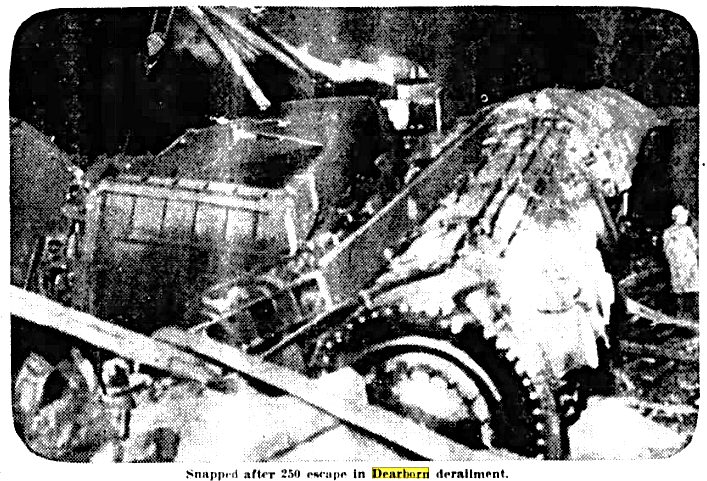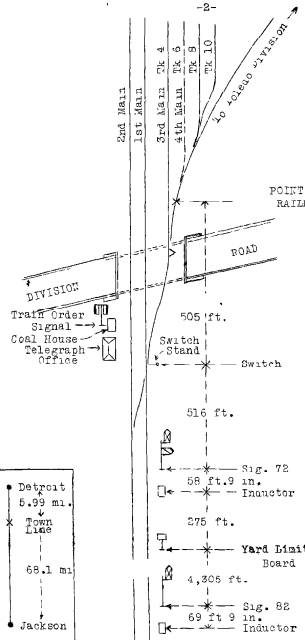- Details
- Hits: 21
Story: Open Switch Wrecks Train in Dearborn - 250 Passenger Lives Periled - 1931
From the Detroit Free Press, March 7, 1931
- Only Two Hurt When Flier Crashes in Dearborn
- Crew Scalded by Live Steam
- Engine Crashes Into Freight Cars on Siding
- Wrecked Engine in Ditch

 The locomotive and nine cars of an eastbound Michigan Central passenger train were derailed at 6:20 p.m. Friday when the train, traveling at 55 miles an hour, passed through two open switches at Town Line, just east of the Greenfield road viaduct and crashed into freight cars on the siding.
The locomotive and nine cars of an eastbound Michigan Central passenger train were derailed at 6:20 p.m. Friday when the train, traveling at 55 miles an hour, passed through two open switches at Town Line, just east of the Greenfield road viaduct and crashed into freight cars on the siding.
Between 200 and 250 passengers in the coaches escaped injury, but the engineer, Frank Shemp, and the fireman, William LaVive, both of Jackson, were scalded by steam.
The men were treated at the Ford emergency hospital in Dearborn. Shemp was released. LaVive, who was cut about the head and had incurred an injured shoulder, was taken to Grace Hospital in Detroit.
Thrown Into Siding
The train was coming from Chicago and was due in Detroit at 6:30 p.m. The first open switch, a short distance past the viaduct, threw the train on a clear siding.
Before the speed could be slackened, the train hit the second open switch about 700 yards east of Greenfield road and this brought the speeding train into a second siding that was blocked by freight cars.
The locomotive left the tracks and plowed under the freight car, stripping it from its trucks and ripping up the remaining two tracks of the siding. Two gondolas on the last track were hurled into the ditch and the locomotive travelled another 50 feet and buried its nose in the sand at the side of the tracks.
Cars Leave Rails
A mail car, two baggage cars and a diner directly back of the locomotive buckled as the engine hit the freight car and were thrown across the three tracks of the siding. All were torn from their trucks. Five day-coaches also left the tracks but remained upright.
The passengers, although shaken up, were unhurt and no panic followed. Three of the cars remained on the tracks and 40 minutes after the accident the passengers were transferred to these and taken to Detroit.
See Interstate Commerce Commission Accident Report for additional information.
Editors notes: Soon after shift change of the operator at Town Line, he lined up the eastbound signal for what he thought was the oncoming passenger train. At the last moment, he thought the train was an overdue freight train. He ran across the tracks to the switch and changed it at the last moment so that the freight could take the siding into the advanced departure yard. The passenger train, going at high speed, was unable to stop when the signal changed to diverging.
This was perhaps the luckiest moment in the 83 year history of the Michigan Central railroad. After diverging into the siding at 55 mph, the locomotive and four cars turned on their side. Normally, trains diverging to a siding are limited to 15 mph or less.
This switch is still in existence and sits very near the Greenfield Road overpass. It is a miracle that the train did not spill 40' down onto Greenfield Road.
The Town Line "interlocking" panel in the switch tenders shanty was actually not an interlocker at the time like other signal towers. It simply controlled automatic block signals and depending on the switch to the yard displayed "proceed" on the main line or "diverging" (slow) route to the yard or wye. There was no timer in place at the time, preventing a switch change in front of a speeding train which all real interlockings have in place. In later versions of this panel, timers were installed, but the crossovers and junction were never interlocked.
It is interesting that the scalded train crew was taken to the Ford "hospital" in Dearborn, which was actually the hospital at the nearby Ford's Rouge Plant/Works. In 1931, Dearborn did not have a hospital and ambulances normally transported sick and injured to Delray Hospital or perhaps to Wayne County General Hospital in Nankin Township (Westland).
The facing point crossover did not exist at the time of this accident, nor did the "new" wye leading to the Junction Yard branch and Schaefer Tower. They were added at a later time.
Image info: Top, the headiness about story from the Detroit Free Press [DFP-1931-0307]. 2nd image, the map provided by the Interstater Commerce Commission investigation.
Bibliography
The following sources are utilized in this website. [SOURCE-YEAR-MMDD-PG]:
- [AAB| = All Aboard!, by Willis Dunbar, Eerdmans Publishing, Grand Rapids ©1969.
- [AAN] = Alpena Argus newspaper.
- [AARQJ] = American Association of Railroads Quiz Jr. pamphlet. © 1956
- [AATHA] = Ann Arbor Railroad Technical and Historical Association newsletter "The Double A"
- [AB] = Information provided at Michigan History Conference from Andrew Bailey, Port Huron, MI

